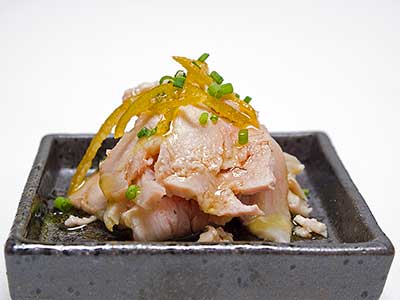June 9, 2014
Amuse-Bouche

salade de lapin
(rabbit salad)
With a pair of toothed forceps I would lift the belly skin to separate it from the underlying muscles. Then with a small pair of scissors, I’d start cutting along the rabbit’s midline in a cranial direction from near the pubis until the midpoint of the ribs. I would separate the skin from the underlying muscles by sliding my gloved hand between the two, breaking any of the small membranous connections that tenuously connected them. I inserted a series of damp sponges partially under the skin and then folded them back over the fur to keep it out of the surgical field. Now with the abdominal muscles fully exposed, I’d make a small incision with the laser along the midline, midway between the sternum and the pelvis. Once the incision was large enough to enable holding each side with a forceps, I’d hand the laser handpiece over to one of the surgeons I was teaching. If I was lucky, he wouldn’t kill the rabbit in the first few seconds.
Before I ever had a chance to cook a rabbit, let alone butcher one, I had many years experience using rabbits as a teaching tool for laser surgery. The rabbits were ordered from a laboratory supply house. Generally, they were large and pissed off—I would have been too. I was always happy when there was a technician on site. The technician would anesthetize the rabbits. There were times when I travelled to different surgery centers around the country where the center had failed to hire a technician. That meant that I had to anesthetize them and, if necessary, euthanize them as well. One surgery center in Milwaukee had even failed to arrange for the proper disposal of the carcasses. It was left up to me to figure what to do with two dozen dead rabbits as I scrambled, already late, to the airport.
Ten years later I was in the French countryside helping to butcher my first rabbit for food. The rabbit was a large hare that a hunter had shot. Unlike the domestic rabbits I buy from my supplier, this one had not been bled. By the time the fur was open on the belly, the whole work table looked like a crime scene. I was amazed that the finished dish didn’t have any dried blood or fur in it.
Ten years ago I could buy nice-sized rabbits for under ten dollars. I was eating rabbit at least twice a month. Then my source dried up. Now I’m lucky to prepare it about once a year. This spring was an exception. I had the opportunity to obtain two large rabbits from a local rancher for a small sum. Whole, they were too large for my freezer so I had to butcher them the day they arrived. I decided to bone them, and then to roll each into a tight cylinder for freezing and cooking. The smaller rabbit finished at slightly less than 1 kg (2 lb) and the larger one at about 1-1⁄3 kg (3 lb). Then, when the occasions arrived, I gently cooked each at 60 °C (140 °F) for about 6 hours. Sliced and served with a sauce masala, they were fantastic. But in both cases, there were leftovers. I hate leftovers. Which brings us to today’s amuse-bouche.
I woke up recently thinking about the thinly sliced pork used in the Japanese dish shabu-shabu. The meat is eaten, maybe with a dipping sauce, hot out the broth used to cook it. I wondered how the meat would be cold with a vinaigrette. I had a pork tenderloin sitting in my freezer, and the method I use for a Japanese dish called yude buta reisei would be ideal for producing the cooked pork slices I was envisioning. That one pork tenderloin would have produced about forty portions, far too many, so I decided to use the chunk of the leftover rabbit.
I sliced the rabbit into thin slices using the kiritsuke (sashimi knife) I made in Japan last year. The slices were arranged in individual serving dishes. Rabbit has a very mild flavor, and I was in the mood for a little sweetness, so I added a few thin strips of candied blood orange peel. (Thank you, Sonia.) The dressing was simply 1 part ginger syrup, 1 part sherry vinegar, and 2 parts extra-virgin olive oil emulsified with a pinch of fine salt. I had some chives in the refrigerator, so these were added at the end for a little color.
Practically any thinly sliced cold, cooked meat would work for this salad. The dressing can also be almost any preparation. The garnish can also be left to your imagination. I think the next time I have some cold pork tenderloin I’m going to make a salad with candied ginger strips and a ginger vinaigrette.
© 2014 Peter Hertzmann. All rights reserved.
